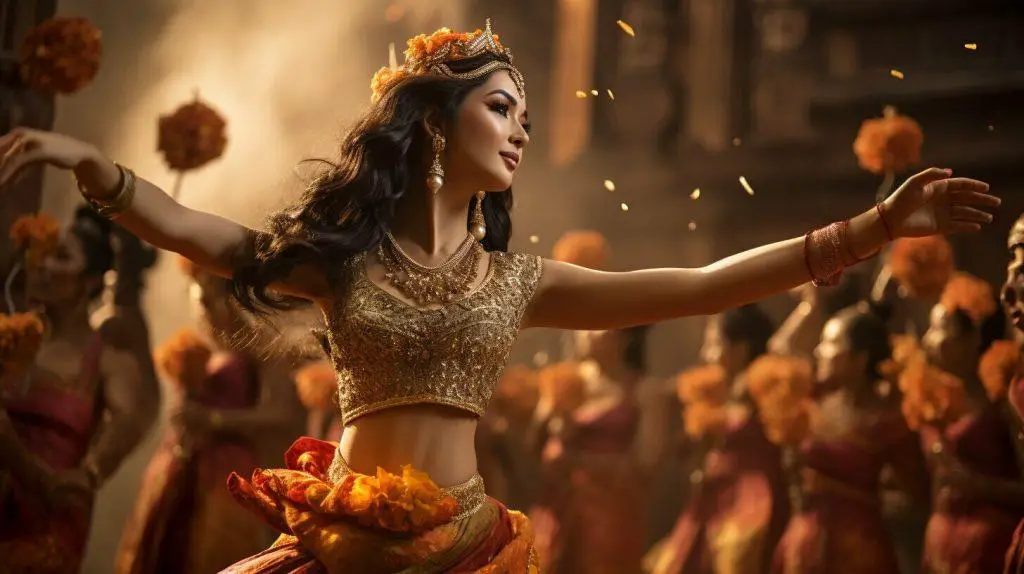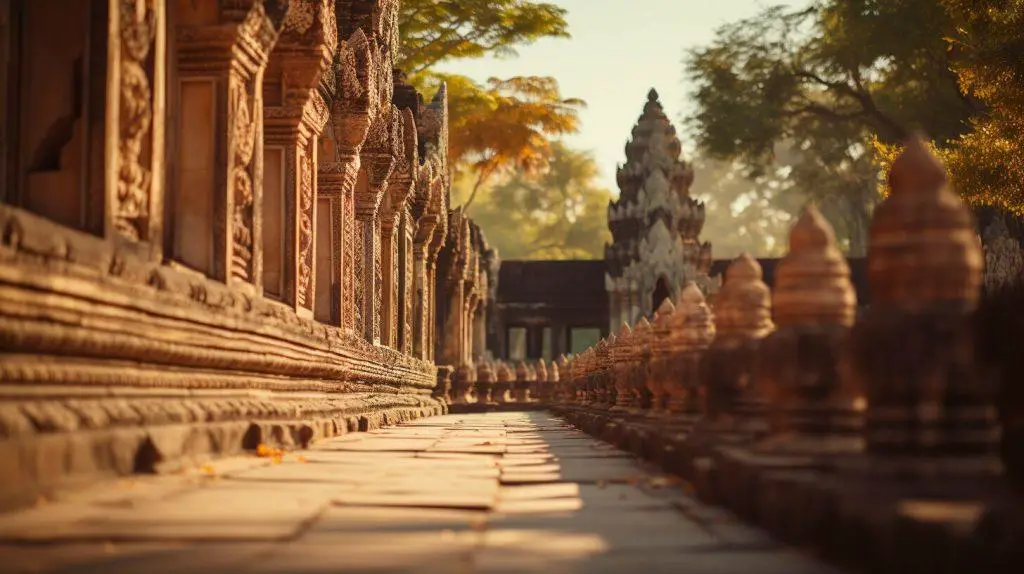The Apsara dance is a form of traditional Khmer dance that holds deep symbolic meaning in Cambodian culture. Known for its graceful movements, intricate hand gestures, and traditional costumes, the Apsara dance is an iconic representation of Cambodian heritage and spirituality.
Key Takeaways
- The Apsara dance is a traditional Khmer dance form that holds deep symbolic meaning in Cambodian culture.
- The dance is known for its graceful movements, intricate hand gestures, and traditional costumes.
- The Apsara dance is an iconic representation of Cambodian heritage and spirituality.
Origins of the Apsara dance
The Apsara dance has its roots in Hindu mythology and its association with the Khmer Empire, one of the most powerful empires in Southeast Asia. According to Hindu mythology, Apsaras were celestial nymphs who danced for the gods in heaven. In Cambodia, the Apsara dance is believed to have originated during the Angkor period, between the 9th and 15th centuries, when the Khmer Empire was at its peak.
During this time, the Apsara dance became an integral part of court rituals and celebrations. It was performed by trained dancers who were highly esteemed in Khmer society. The dance form was also influenced by other Southeast Asian traditions, including those from India and China.
Origins of the name
The term “Apsara” comes from the Sanskrit word “apsaras,” meaning “celestial nymph.” In Cambodia, the Apsara dance is also known as “Robam Tep Apsara,” which translates to “the dance of the celestial nymphs.”
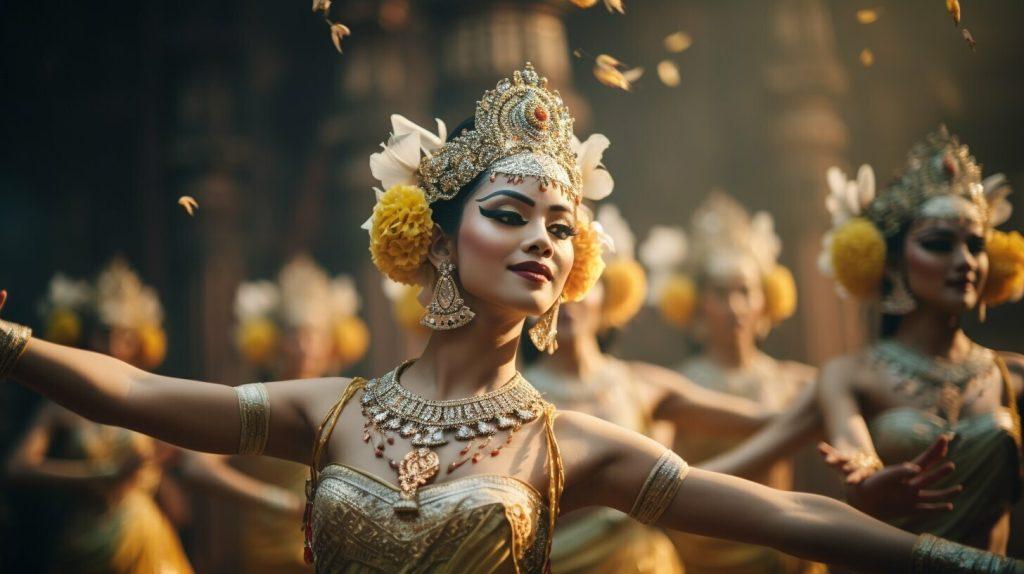
The Apsara dance and the Khmer Empire
The Apsara dance was not only a form of entertainment but also a way for the Khmer Empire to showcase its power and wealth. The dance was performed during important state ceremonies and religious festivals, such as coronations, weddings, and funerals. It was also believed that the Apsara dance helped to bring prosperity and good fortune to the country.
Over time, the Apsara dance became a symbol of Khmer culture and identity. It was passed down from generation to generation, with each new dancer adding their own unique style and interpretation.
Apsara dance movements and costumes
The Apsara dance is known for its intricate and graceful movements that are meant to mimic the celestial nymphs. Dancers often use subtle hand gestures and fluid footwork to portray the ethereal beauty of the Apsaras. The dance is performed in a slow and elegant manner, with each gesture and step carefully choreographed to convey a specific meaning.
The traditional costumes worn by the Apsara dancers are an essential part of the performance. The dancers wear long and flowing silk dresses adorned with golden accessories and headdresses. The dresses are typically made of richly embroidered silk and are designed to resemble the heavenly robes of the Apsaras. The headdresses are often decorated with intricate jewels and feathers, adding to the beauty and elegance of the overall performance.
The dancers also wear traditional makeup, consisting of a white base with black and red accents. The makeup is intended to highlight the facial expressions of the dancers and emphasize the ethereal beauty of the Apsaras. Overall, the costumes and makeup are an integral part of the Apsara dance, helping to transport the audience to a mystical and enchanting realm.
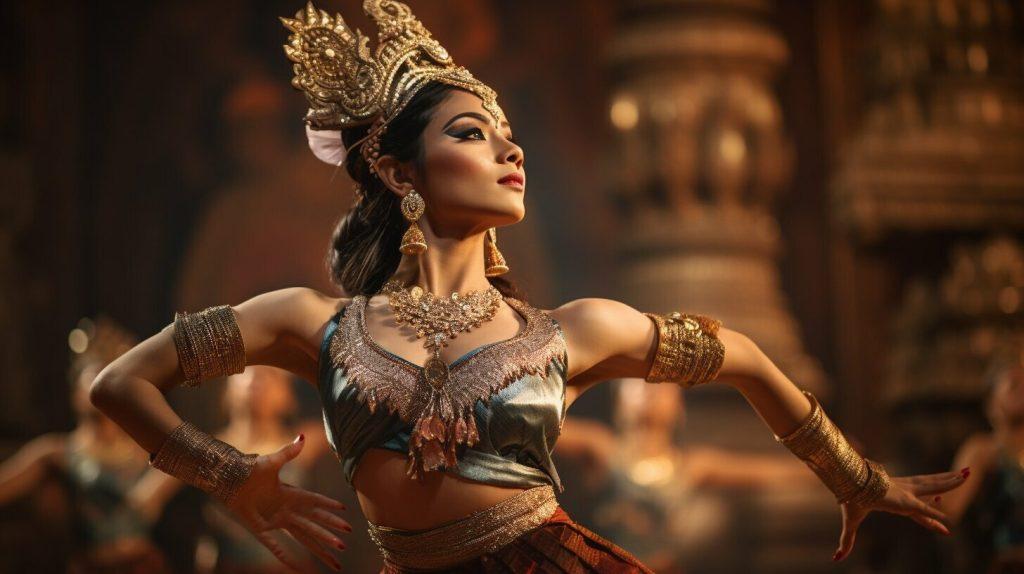
Note: Apsara dancers in traditional costumes
Symbolic meaning of the Apsara dance
The Apsara dance holds deep symbolic meaning in Cambodian culture. It represents spirituality, femininity, and the connection between humans and the divine. The graceful and elegant movements of the dancers embody the ethereal beauty of the celestial nymphs.
According to Hindu mythology, Apsaras are heavenly nymphs who are renowned for their incomparable beauty and grace. They are often depicted as dancers, singers, and musicians who entertain the gods in the celestial palace. In Cambodia, the Apsara dance is seen as a way to connect with the divine and evoke the essence of these celestial figures.
The Apsara dance is also considered a form of spiritual practice and meditation. The dancers use their body language and hand gestures to convey a sense of fluidity, balance, and serenity. Their movements are intended to create a sense of harmony and tranquility, helping the audience to connect with a higher power and find inner peace.
Furthermore, the Apsara dance celebrates the feminine ideal, embodying the grace, beauty, and elegance that are often associated with women. It is considered a homage to the feminine spirit and a way to honor the powerful role of women in Cambodian society.
Example
“The Apsara dance is more than just a form of entertainment. It represents our connection to the divine and our reverence for the feminine ideal. Watching the graceful movements of the dancers is a meditative experience that helps us find inner peace and spiritual harmony.” – Cambodian cultural expert, Nith Narong
Overall, the Apsara dance holds great cultural significance in Cambodia. It is a symbol of the country’s rich traditions and heritage, as well as a way to celebrate its spirituality, femininity, and cultural pride.
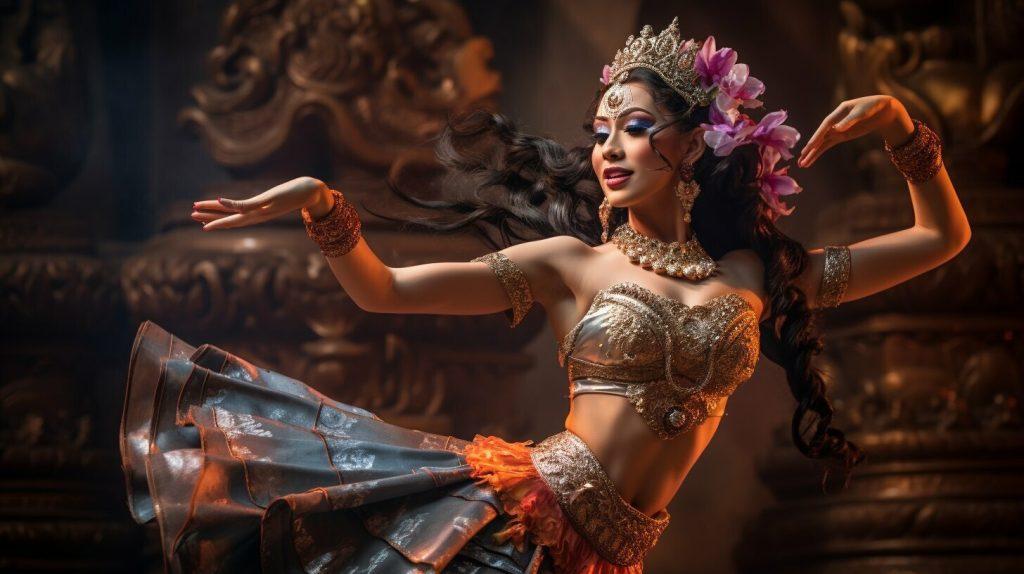
Apsara dance as a cultural preservation
The Apsara dance plays a crucial role in preserving Cambodian culture and heritage. The dance form has been passed down through generations and continues to be taught and performed as a way to safeguard the country’s traditions and identity.
One of the major institutions dedicated to preserving the Apsara dance is the Royal University of Fine Arts in Phnom Penh. The university offers dance courses, including Apsara dance, for young Cambodians to learn about their cultural heritage and develop their artistic skills.
The Apsara Authority, established by the Cambodian government, is responsible for the conservation and restoration of all cultural heritage sites in Cambodia, including those related to the Apsara dance. The organization has collaborated with UNESCO to safeguard the intangible cultural heritage of the Apsara dance.
Through these efforts, the Apsara dance has become a symbol of cultural pride for the Cambodian people. It is a living heritage that represents their traditions, history, and identity.
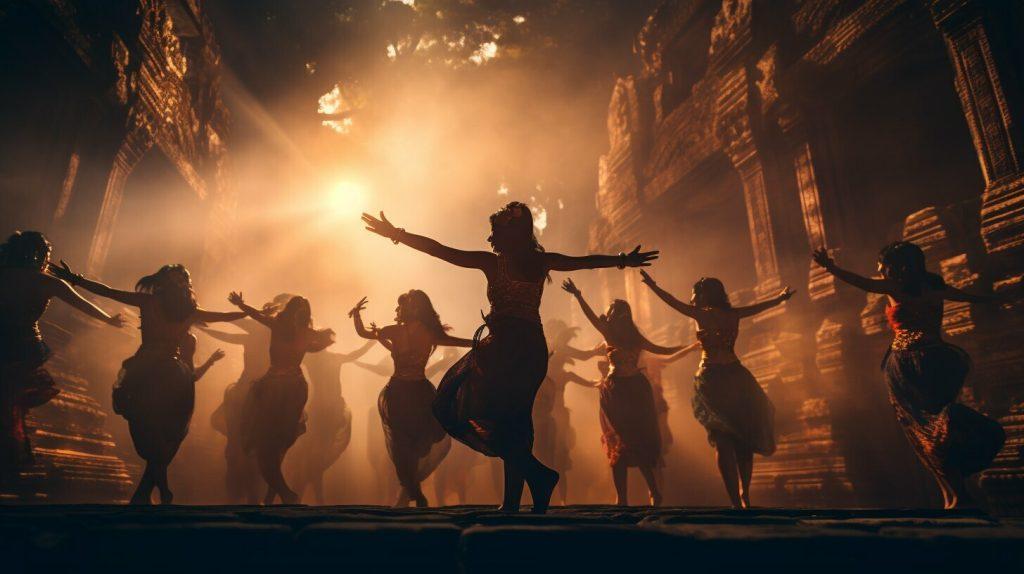
“The Apsara dance represents our culture and our national identity. It is important to preserve and pass down this tradition to future generations so that they can understand and appreciate their heritage.” – Sopheap, a Cambodian dancer and teacher
Apsara Dance Performances and Venues
The Apsara dance is a popular cultural show in Cambodia, often performed in conjunction with dinner or as part of a historical presentation. It is a must-see for tourists who seek to experience the country’s traditional dance forms and cultural heritage.
One of the most popular venues to witness the Apsara dance is near the Angkor Wat temple complex, a UNESCO World Heritage Site and one of the most visited tourist destinations in Cambodia. The area is known for its nightly cultural shows, which feature the dance form.
Other popular venues for the Apsara dance include the National Museum of Cambodia in Phnom Penh, which hosts weekly performances, and the Royal Palace in Siem Reap.
Many restaurants in Siem Reap offer Apsara dance performances as part of their dining experience. For a more authentic and immersive experience, travelers can attend the annual Angkor Sankranta festival, which takes place during the Khmer New Year in mid-April. The festival features traditional music, dance performances, and other cultural activities.
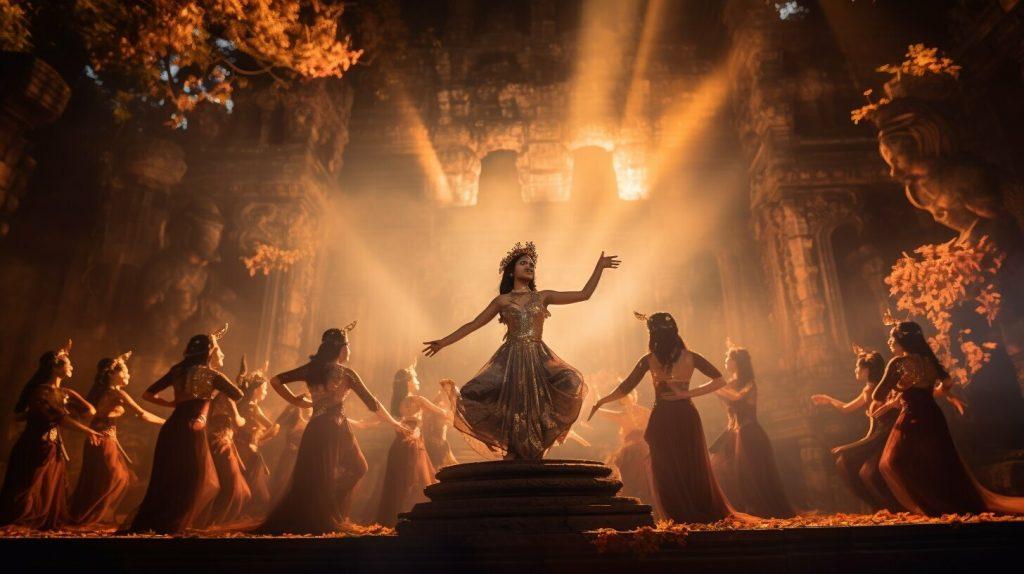
Apsara dance and Cambodian tourism
The Apsara dance has become one of Cambodia’s most popular cultural attractions, drawing tourists from around the world. Visitors are mesmerized by the graceful movements and intricate hand gestures of the dancers, as well as the elaborate traditional costumes that showcase the ethereal beauty of the celestial nymphs.
Many cultural shows featuring the Apsara dance are held in Phnom Penh and Siem Reap throughout the year, with a particular focus on performances near the iconic Angkor Wat temple complex. These events offer visitors an immersive experience of Cambodian culture, providing a glimpse into the country’s rich history and traditions.
Additionally, the Apsara dance has played a significant role in the development of cultural tourism in Cambodia. The country’s unique traditional dance forms have become a major draw for tourists seeking an authentic cultural experience, and many travel packages include a visit to the Angkor temples and an Apsara dance performance as part of the itinerary.
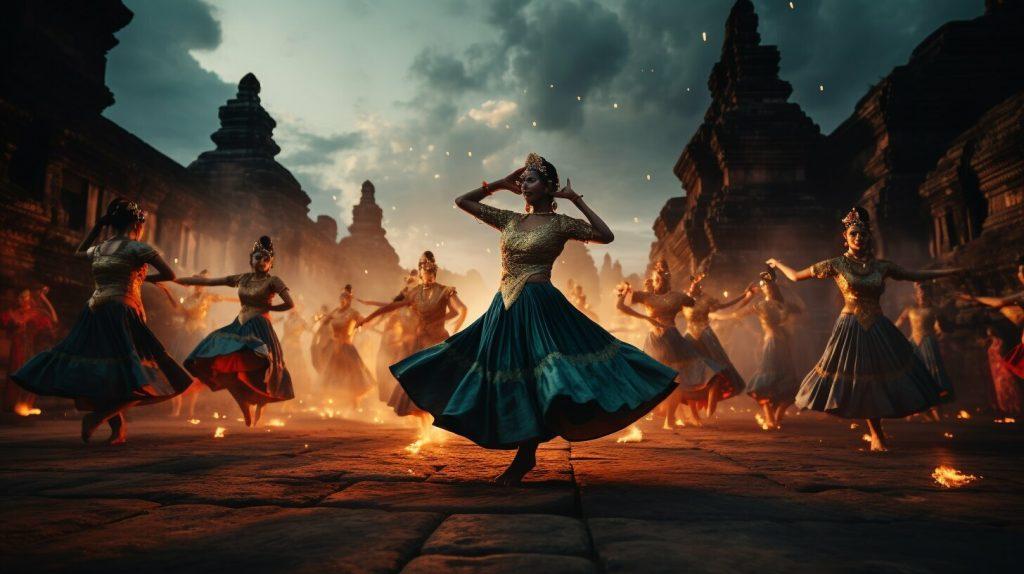
As Cambodia continues to develop its tourism industry, the Apsara dance is poised to play an even greater role in attracting visitors and promoting cultural exchange. Its recognition as a living heritage by UNESCO has further elevated its status as a symbol of Cambodian identity and cultural pride.
Apsara dance in contemporary society
The Apsara dance continues to hold a significant place in contemporary Cambodian society, with efforts being made to promote and preserve this traditional art form. In recent years, dance academies and institutions have been established to train young dancers in the Apsara dance, ensuring its continuation for future generations.
The Apsara Authority, set up in 1995, has played a crucial role in safeguarding and promoting the Apsara dance. The organization oversees the protection and management of the Angkor Archaeological Park and has been instrumental in preserving the cultural heritage of the region.
Thanks to the efforts to preserve and promote the Apsara dance, it has become a popular cultural attraction for tourists visiting Cambodia. Visitors can witness the mesmerizing dance performances at various cultural shows held across the country, particularly those near the iconic Angkor Wat temple complex.
In addition to its popularity in Cambodia, the Apsara dance has gained international recognition and has been showcased in various international events and festivals. These performances contribute to cultural exchange, promoting Cambodian arts and traditions globally.
The Apsara dance has also played a significant role in empowering women in Cambodian society. Traditionally, dance forms in Cambodia were dominated by men, but the Apsara dance has provided opportunities for women to excel and challenge gender roles. Through this dance form, Cambodian women have been able to express themselves and gain a sense of pride and empowerment.
Overall, the Apsara dance serves as a living heritage, representing the country’s rich cultural identity and traditions. Its inclusion on UNESCO’s Representative List of the Intangible Cultural Heritage of Humanity further underlines its importance and the need to preserve it for future generations.
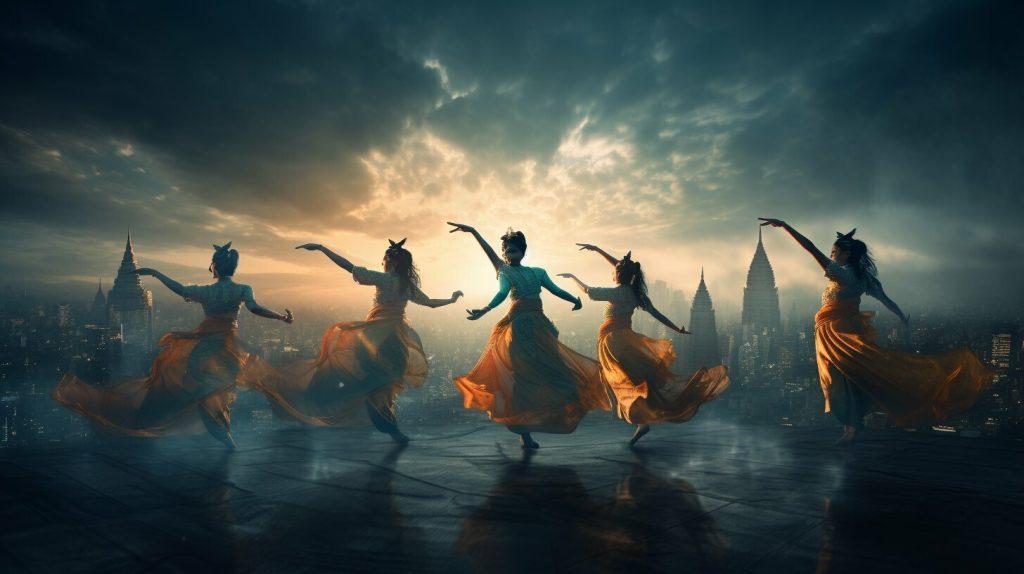
Apsara dance beyond Cambodia’s borders
The Apsara dance has gained international recognition and is admired as an exquisite form of art. It has been showcased in various international events and festivals, promoting cultural exchange and the richness of Cambodian arts and traditions worldwide.
The Royal Ballet of Cambodia, which includes the traditional Apsara dance, has performed internationally, including at the Paris Opera House and the Kennedy Center in Washington, D.C. In 2003, the UNESCO-sponsored “International Festival of the Dance of the Golden Age” in Phnom Penh featured the Apsara dance and other traditional Khmer dances. The festival aimed to present Cambodian performing arts, to bring together artists from countries of the Asia-Pacific region, and to promote and preserve the traditional culture of Cambodia.
The Apsara dance has also been recognized as a living heritage and included on UNESCO’s Representative List of the Intangible Cultural Heritage of Humanity since 2008. The listing acknowledges the importance of the dance form as a cultural tradition that requires protection and preservation for future generations.
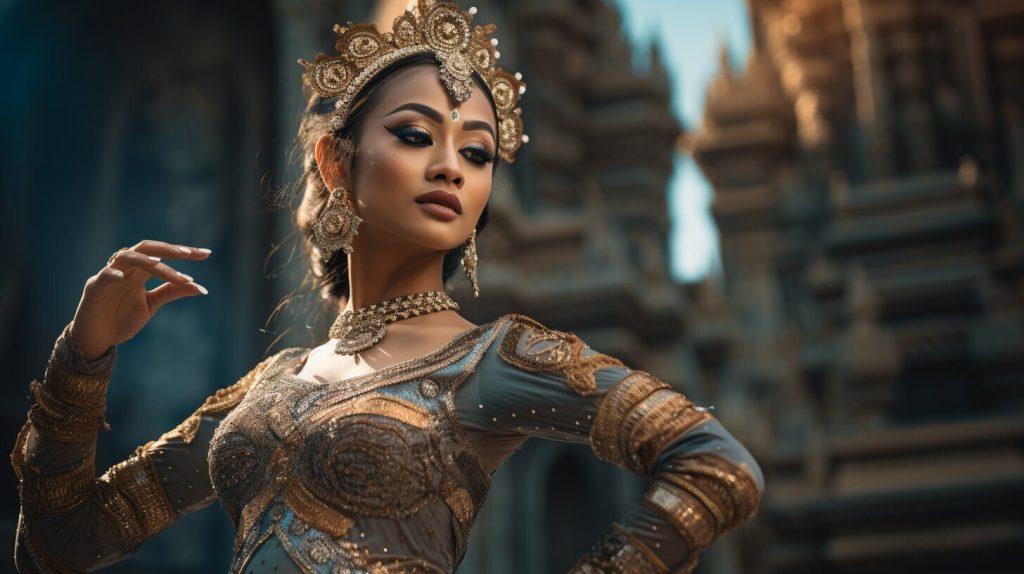
Image description: A group of Cambodian dancers in traditional Apsara costume performing on stage at the UNESCO headquarters in Paris.
Apsara dance and gender empowerment
The Apsara dance has played a significant role in empowering women in Cambodian society. Traditionally, women were expected to adhere to strict gender roles, with limited opportunities for education and personal growth. However, the Apsara dance has provided a platform for women to showcase their talents and challenge societal expectations.
In the early years, the Apsara dance was performed exclusively by women in the royal court. However, with the decline of the monarchy, the dance form became more accessible to the general public, providing women from all walks of life with the opportunity to participate.
The Apsara dance has also enabled women to become financially independent. Many dance academies and institutions have been established to teach the art form, providing employment opportunities for women as performers, teachers, and choreographers.
This has had a positive impact on the lives of many women, enabling them to break free from traditional gender roles and contribute to their families and communities. The Apsara dance has become a symbol of women’s empowerment in Cambodia, inspiring many to pursue their dreams and aspirations.
In recognition of its contribution to gender empowerment, the Apsara dance has been included in the UNESCO Representative List of the Intangible Cultural Heritage of Humanity. This highlights the importance of preserving this traditional art form for future generations, ensuring that it continues to empower women and promote gender equality in Cambodian society.
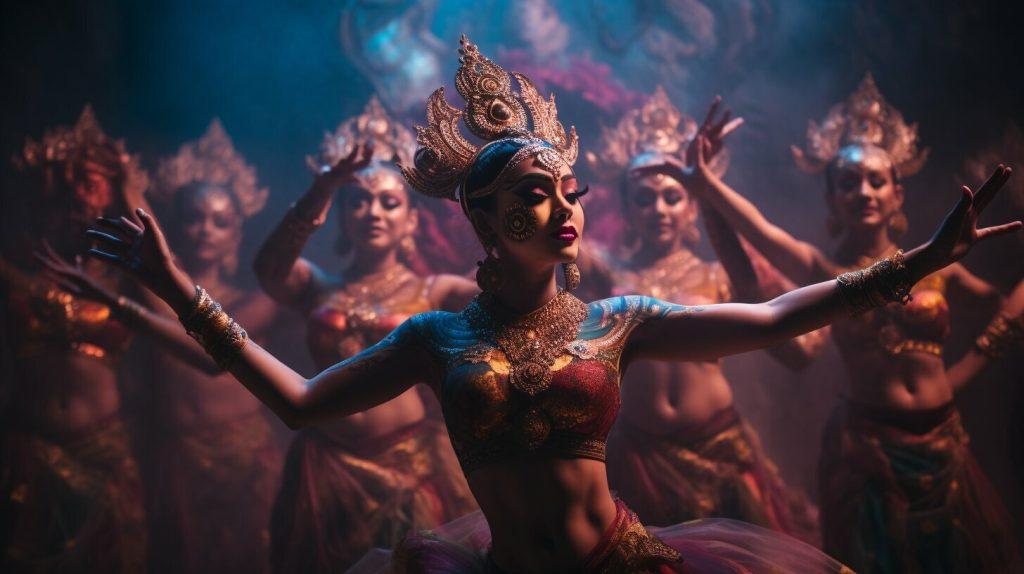
Apsara dance: A living heritage
Recognized as a fundamental part of Cambodian identity and cultural heritage, the Apsara dance has been included on UNESCO’s Representative List of the Intangible Cultural Heritage of Humanity since 2003. As a living heritage, the dance form represents the ongoing transmission of culture and traditions from one generation to the next.
The listing emphasizes the importance of safeguarding the Apsara dance and ensuring its continued survival, particularly in the face of modernization and globalization. It recognizes the significance of the dance form as a symbol of Cambodia’s history, spirituality, and feminine grace, and its role in preserving the country’s unique cultural identity.
The Apsara dance has also become a source of cultural pride, inspiring a sense of ownership and belonging among the Cambodian people. It serves as a reminder of the country’s rich cultural heritage and its resilience in the face of adversity, and has helped to shape Cambodia’s national identity as a whole.
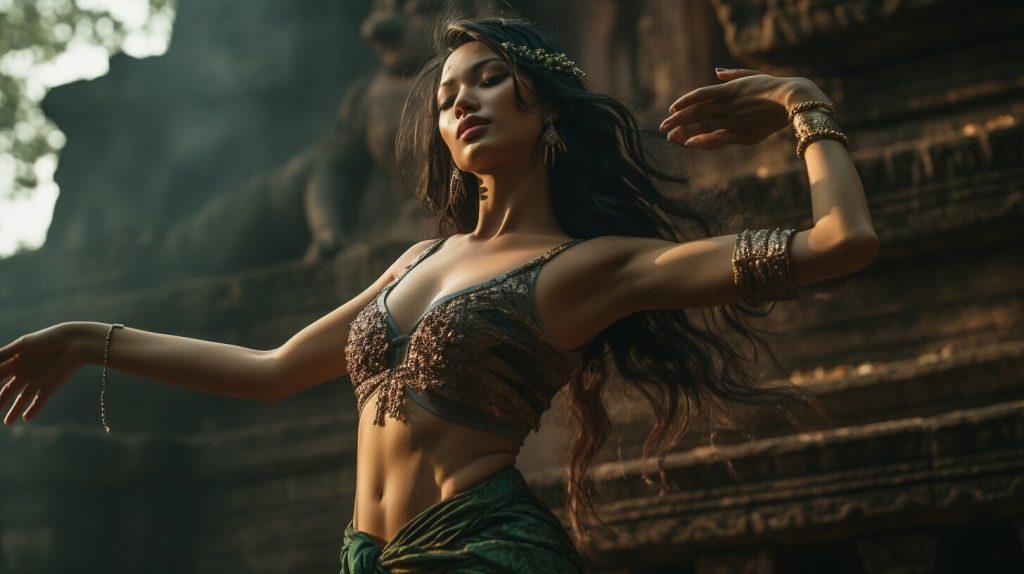
Through its recognition on the UNESCO list, the Apsara dance has gained international attention and appreciation, spreading awareness of Cambodia’s cultural heritage and contributing to cultural exchange and dialogue. It has also served as a source of inspiration for other traditional dance forms around the world.
The ongoing efforts to preserve and promote the Apsara dance, both locally and globally, have ensured that this living heritage continues to thrive and evolve, adapting to changing times while remaining true to its roots. As a symbol of Cambodian pride and identity, the Apsara dance is set to endure for generations to come.
Conclusion
The Apsara dance holds deep cultural significance in Cambodia, representing spirituality, femininity, and the connection between humans and the divine. Through its graceful and intricate choreography, traditional costumes, and unique hand gestures, the dance form embodies the ethereal beauty of celestial nymphs.
The Apsara dance plays a crucial role in preserving Cambodian culture and heritage, passed down through generations and taught in institutions dedicated to its promotion. Its popularity in cultural shows and performances near the iconic Angkor Wat temple complex has also contributed to its status as a notable cultural attraction for tourists, enhancing the overall experience of visitors.
Beyond Cambodia’s borders, the Apsara dance has gained international recognition, showcased in various events and festivals, promoting cultural exchange and representing Cambodian arts and traditions on a global scale. Additionally, the dance form has empowered women in Cambodian society, providing opportunities for women to excel and challenge traditional gender roles.
The Apsara dance has been recognized as a living heritage and included on UNESCO’s Representative List of the Intangible Cultural Heritage of Humanity, underscoring its importance for Cambodia’s identity and cultural pride. Efforts to ensure its continued preservation and transmission to future generations highlight the ongoing significance of this traditional art form in contemporary society.
FAQ
What does the Apsara dance symbolize in Cambodia?
The Apsara dance symbolizes the rich cultural heritage of Cambodia and holds deep significance in the country’s history and traditions.
What are the origins of the Apsara dance?
The Apsara dance can be traced back to Hindu mythology and its association with the Khmer Empire, becoming an integral part of Cambodian culture.
What are the movements and costumes involved in the Apsara dance?
The Apsara dance is known for its unique and graceful movements, accompanied by traditional costumes that portray the ethereal beauty of the celestial nymphs.
What is the symbolic meaning of the Apsara dance?
The Apsara dance holds symbolic meaning, representing spirituality, feminine grace, and the connection between humans and the divine.
How does the Apsara dance contribute to cultural preservation?
The Apsara dance plays a vital role in preserving Cambodian culture and heritage, being passed down through generations and taught as a way to safeguard traditions and identity.
Where can Apsara dance performances be witnessed in Cambodia?
Apsara dance performances can be witnessed in cultural shows, particularly those held near the iconic Angkor Wat temple complex.
How does the Apsara dance contribute to Cambodian tourism?
The Apsara dance attracts tourists from around the world and has become one of Cambodia’s notable cultural attractions, enhancing the overall tourism experience.
What is the role of the Apsara dance in contemporary society?
The Apsara dance continues to thrive in contemporary Cambodian society with the establishment of dance academies and the work of the Apsara Authority in preserving and promoting this traditional art form.
How has the Apsara dance gained international recognition?
The Apsara dance has been showcased in various international events and festivals, contributing to cultural exchange and promoting Cambodian arts and traditions globally.
How does the Apsara dance empower women?
The Apsara dance provides opportunities for women to excel and challenge traditional gender roles, fostering empowerment and pride in Cambodian society.
Is the Apsara dance recognized as a living heritage?
Yes, the Apsara dance is recognized as a living heritage and is included on UNESCO’s Representative List of the Intangible Cultural Heritage of Humanity.
